Gardening has been around for centuries — an old-fashioned pleasure and also a survival skill. As Master Gardeners our task is to “make recommendations ... disseminate scientifically defensible information approved by the University of California” to others also interested in gardening. Yet the style of our own garden can't easily be pinned down and our preferences are probably as varied and unique as our individual personality, philosophy, heritage, and experiences.
Some of us prefer symmetry and organization in our gardens. Others of us allow plants “that are making a go of it” to simply grow — whenever and wherever they want. The older I get, the more I recognize that I often stand with feet in both furrows, juggling my expectations with seasonal realities and the inevitability of change.
Here's a cursory glance at six garden styles that changed the English countryside from the 1st to the 20th century as each style superseded the prior style for a myriad of reasons:
Roman gardens were planted on the grounds of villas and palaces after the conquest of Brittan during 1st century AD. These gardens featured formal low box hedges and gravel walkways. Statues and urns adorned niches. Seating areas were incorporated into these gardens. Plants brought from the Mediterranean were mixed with native species.
Medieval gardens that appeared in England during the Middle Ages were often small enclosed areas featuring kitchen and herb gardens for food and medicine, especially within the courtyards of cloistered monasteries and on castle grounds in which “turf seats” or mounds offered views above the walls.
Tudor gardens were enclosed by walls or hedges, reflecting Renaissance ideals of order and control. These gardens mirrored the Italian influence of creating harmony and lineal proportion by aligning the garden with the house. Ornate statues and sundials made a comeback. Intriguing patterns were introduced by arranging the low hedges in intricate patterns, known as “knots.” White represented the purity of purpose. Green conveyed strength and virility.
Stuart gardens took the patterned garden to a grander scale under the rule of Charles II in 1660. Following his return from exile in France with two of Louis XIV's gardeners, French-style gardens were the rage — formal flowerbeds surrounding the house, rectangular patterned hedges, large walking paths and avenues, some lined with trees, fanning out from a central point.
Georgian gardens meant informal park-like settings with landscaped grounds and gardens. The manor house became part of the farmland. Trees were planted in clusters instead of lining avenues, rectangular ponds evolved into circular lakes as a natural look replaced formality. Head gardener at Stowe Gardens, Lancelot “Capability” Brown, was so passionate about this style that he promoted the “lawn mowing” cattle and sheep to graze right up to the windows of a house.
Victorian gardens brought back the flowerbeds and color. Seedlings and starts raised in greenhouses provided the “bedding out plants.” Citrus trees from China and never before seen plant species collected during expeditions could now be propagated in a protected space. Chatsworth House in Derbyshire, which was heated by coal, was one of the largest greenhouses with 7,035 square feet of glass. Public gardens and green spaces were introduced. The cottage garden led the way into the 20th century through the passion and persistence of gardener, Gertrude Jekyll, who saw her flowerbeds as a large painting canvas after a doctor told her to give up both painting and embroidery because of her poor eyesight.
Garden style trivia quiz — True or false?
Roman gardens often had a small kitchen garden that included common fruits and vegetables?
Medieval gardens in monasteries featured a well and fountain centered in an open space surrounded by covered walkways?
Knotted patterns in Tudor gardens were influenced by fashion — the crisscross strap-like patterns displayed in home decor, embroidered on clothing and featured on jewelry?
The formal flowerbeds in Stuart gardens are known as “parterres”?
Starting in 1714, Georgian gardens were designed with a large deep ditch that separated the house from the park-like landscape to kept grazing animals at a distance without the need to install a fence or plant a hedge that would spoil the view?
Victorian gardens with glass conservatories for raising bedding plants were expensive in the early 19th century due to a tax on glass?
The correct answer to each question is true.
-----------------------
Sources:
California Master Gardener's Handbook, Chapter 1 Overview, “Master Gardeners and The Many Philosophies of Home Gardening,” pg 3
Posted on
Thursday, March 7, 2019 at
9:15 AM
"Where can kids learn beekeeping for free?" someone asked us last week.
One of the ways is through...
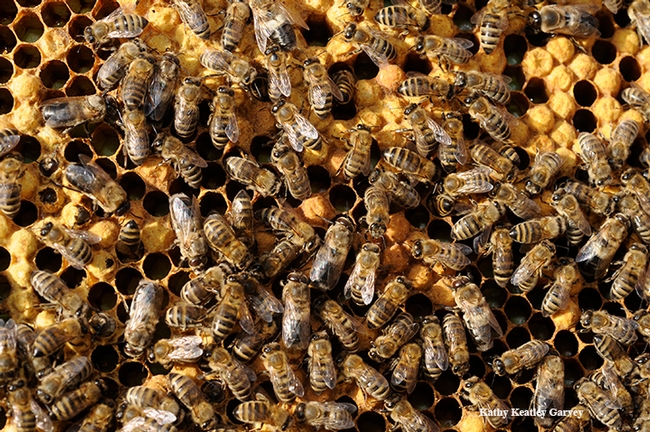
Honey bees at work. (Photo by Kathy Keatley Garvey)
Honey bees at work. (Photo by Kathy Keatley Garvey)

Elmira 4-H Club member Kailey Mauldin gets ready to present an interpretative reading on "The Secret Life of Bees" at the Solano County 4-H Presentation Day. (Photo by Kathy Keatley Garvey)
Elmira 4-H Club member Kailey Mauldin gets ready to present an interpretative reading on "The Secret Life of Bees" at the Solano County 4-H Presentation Day. (Photo by Kathy Keatley Garvey)
Posted on
Wednesday, March 6, 2019 at
2:31 PM
When I think of spring, I think of yellow: African daisies, poppies, oxalis, tidy-tips, and daffodils. And one of my favorite things to do in early spring is taking a road trip to Volcano to visit McLaughlin's Daffodil Hill.
Daffodil Hill is part of a ranch that has been owned by the McLaughlin family since the late 1800s. History has it that the family bought the ranch from Pete Denzer, who was originally from Holland, and who planted daffodils to remind him of his homeland. Mrs. McLaughlin loved the daffodils. Each year she would divide and then replant the daffodil bulbs, and each year the flower display grew more spectacular. Today the daffodils cover 7 acres, and her great-grandchildren, the current ranch owners, continue to plant thousands of bulbs each year.
Sometime in the 1940s, the display became a destination for visitors in early spring. My husband and I go almost every year. We would go every year, but Daffodil Hill doesn't always get a chance to open to the public for visitation. Last year the flowers just started to bloom in late February, and they were pelted by rain, hail, sleet, and snow through March. The flowers didn't recover in time for the Hill to reopen. Another year we went on the last day of the single week they were able to be open. Most years they are open for 3 to 4 weeks starting sometime in March. Visitation is very weather-dependent. The trails through the garden are packed clay and get quite slick in the rain. Since the display is on a hillside, for safety reasons, Daffodil Hill is not open when it is raining or when it has recently rained. When it is open, the display is glorious and well worth the drive. Wear layers, pack a picnic lunch and plan to take lots of pictures. Check before driving up there to see if they are going to be open that day. Parking is free and available across the road from the gardens. Pets are not allowed. Entry is also free, but donations are gladly accepted. I usually check their Facebook page to see if they will be open. You can also call. Take a look on Facebook now, and you will see a picture of the entire hillside covered in a thick blanket of snow. It may be a while before they open.
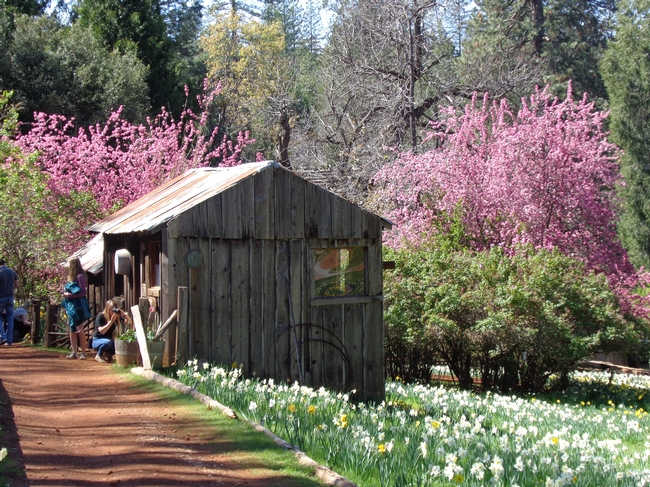
photos by Michelle Davis
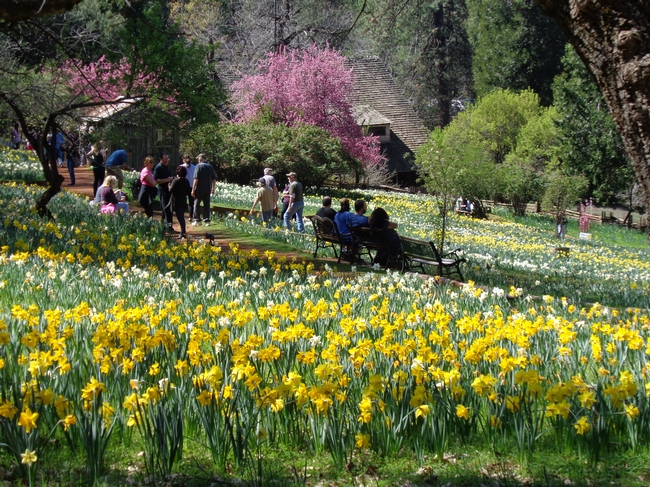
photos by Michelle Davis
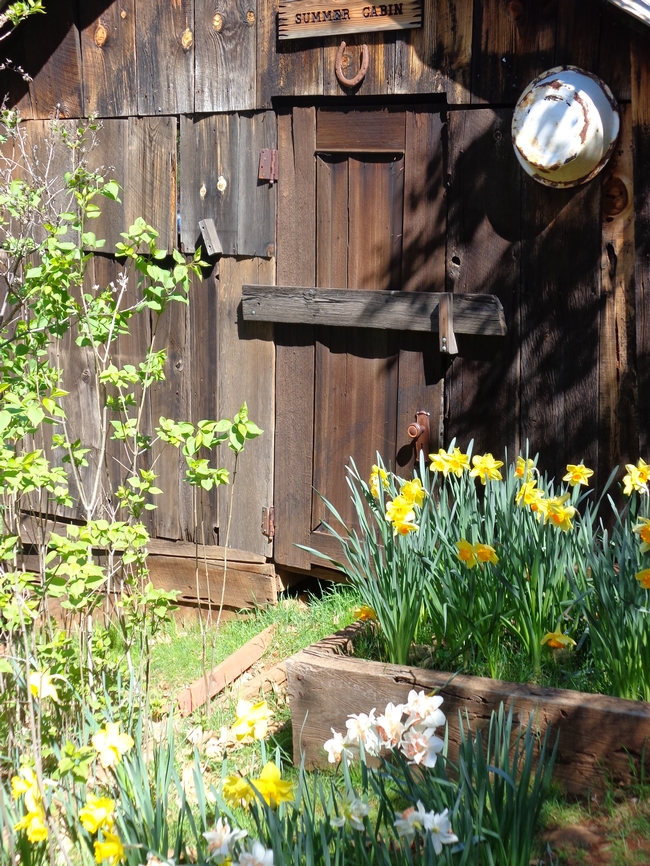
DSC00538
Posted on
Wednesday, March 6, 2019 at
11:57 AM
Pollinators aren't just bees, butterflies, beetles and bats.
They're also birds, like...
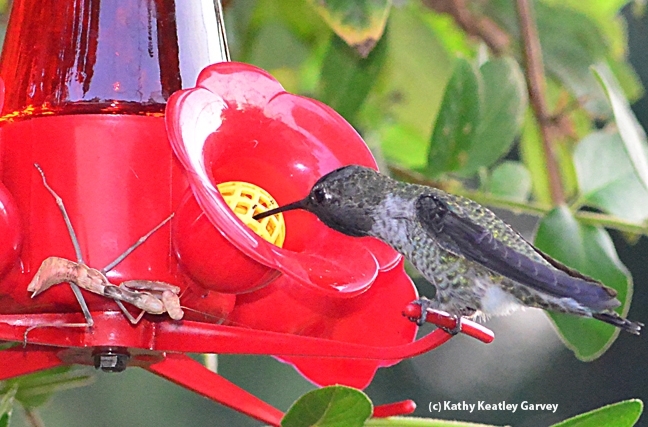
Hummingbirds eat insects and insects eat hummingbirds. Here a praying mantis lurks by a hummingbird feeder. It was quickly removed to another spot. (Photo by Kathy Keatley Garvey)
Hummingbirds eat insects and insects eat hummingbirds. Here a praying mantis lurks by a hummingbird feeder. It was quickly removed to another spot. (Photo by Kathy Keatley Garvey)
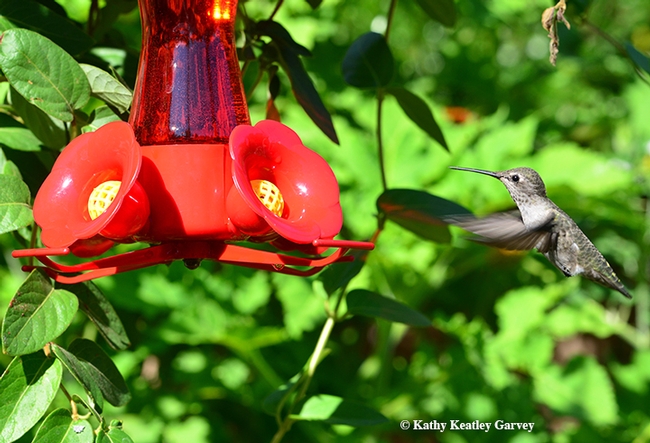
A hummingbird flies in for a quick burst of energy. It is best not to use red dye in a feeder; some companies make hummingbird feeders with red glass. (Photo by Kathy Keatley Garvey)
A hummingbird flies in for a quick burst of energy. It is best not to use red dye in a feeder; some companies make hummingbird feeders with red glass. (Photo by Kathy Keatley Garvey)
Posted on
Tuesday, March 5, 2019 at
4:30 PM
Enough rain, cold and snow?
Plenty of water for Spring plants
Can you feel and think Spring?

photo by Jennifer Baumbach
Posted on
Tuesday, March 5, 2019 at
3:34 PM











